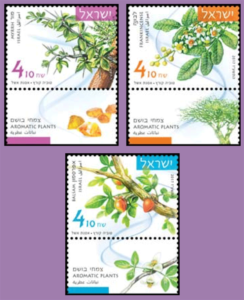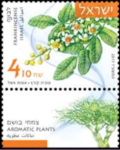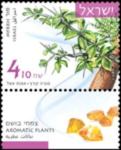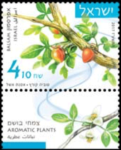from Israel Post; these stamps will be issued February 7, 2017:
 “Who is she that comes up from the desert like columns of smoke, in clouds of myrrh and frankincense, of all the powders of the merchant” (Song of Songs 3:6).
“Who is she that comes up from the desert like columns of smoke, in clouds of myrrh and frankincense, of all the powders of the merchant” (Song of Songs 3:6).
The Aromatic Plants stamp series features different types of myrrh and frankincense, aromatic plants which were very significant in the history of Eretz Israel.
Today, Aromatic Plants are mostly thought of as fragrant plants used for the production of volatile fragrant materials ñ “essential oils”, by the distillation process. However, in the distant past this process was unknown and perfumes were produced using methods of extraction or resin drainage from certain plants.
Thus, myrrh and frankincense, which grew mainly in the Red Sea area of Africa and the Arabian Peninsula, became an important and precious source for perfumes.
Throughout history, these plants have been used for cosmetics, medicine and mainly for religious rituals in ancient Egyptian, Jewish, Christian and Far Eastern temples.
They are mentioned frequently in the Bible and are among the ingredients used in the incense offering made in the Temple.
The great demand for these plants led to the establishment of trade routes, where caravans of camels carried their wares from the key growing areas to Egypt, Eretz Israel and Europe. Over time, Eretz Israel became an important crossroads on the Incense Route, which was controlled by the Nabateans.
In addition, Eretz Israel was known for growing another well known aromatic plant ñ balsam, which grew mainly in the Dead Sea and Gilead area. Balsam was unique to Eretz Israel and was also used for cosmetics, medicine and incense, and was an important economic resource. Thus, the method for its production was kept confidential, as referenced in the mosaic floor in the ancient synagogue unearthed in Ein Gedi.
Frankincense
 A genus (Boswellia) of the Burseraceae family that includes a number of tree and bush species from which the resin used for the incense called frankincense is derived. The resin is collected in containers after puncturing the bark of the young tree trunk.
A genus (Boswellia) of the Burseraceae family that includes a number of tree and bush species from which the resin used for the incense called frankincense is derived. The resin is collected in containers after puncturing the bark of the young tree trunk.
Myrrh
 A genus (Commiphora) that also belongs to the Burseraceae family which includes species of bushes from which the resin used for the incense called myrrh is derived by slicing the bark of young branches. The species most commonly used is Commiphora mirrha.
A genus (Commiphora) that also belongs to the Burseraceae family which includes species of bushes from which the resin used for the incense called myrrh is derived by slicing the bark of young branches. The species most commonly used is Commiphora mirrha.
Balsam
 The balsam plant is mentioned in ancient writings and is consistent with the biblical Tzori plant which served as the source for producing high quality perfume. After some deliberation regarding the identification of the plant, there is now widespread agreement among researchers identifying it as one of the myrrh species of the Burseraceae family, Commiphora gileadensis, which still grows in the southern Arabian Peninsula. This plant was introduced to Israel and acclimatized in recent years and is now cultivated in the Ein Gedi and northern Dead Sea area.
The balsam plant is mentioned in ancient writings and is consistent with the biblical Tzori plant which served as the source for producing high quality perfume. After some deliberation regarding the identification of the plant, there is now widespread agreement among researchers identifying it as one of the myrrh species of the Burseraceae family, Commiphora gileadensis, which still grows in the southern Arabian Peninsula. This plant was introduced to Israel and acclimatized in recent years and is now cultivated in the Ein Gedi and northern Dead Sea area.
— Prof. Nativ Dudai, Ph.D
The Unit of Medicinal and Aromatic Plants
Agricultural Research Organization, Newe Ya’ar Research Center



